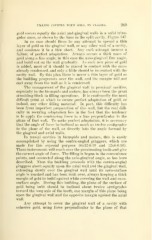Page 569 - My FlipBook
P. 569
FILLING CAVITIES WITH GOLD, BY CLASSES. 269
gold covers equally the axial and gingival walls in a solid trian-
gular mass, as shown by the lines in the split cavity, Figure 347.
In no case should there be any attempt to spread a thin
layer of gold on the gingival wall, or any other wall of a cavity,
and condense it in a thin sheet. Any such attempt insures a
failure of perfect adaptation. Always secure a thick mass of
gold along a line angle, in this case the axio-gingival line angle,
and build out on the wall gradually. As each new piece of gold
is added, most of it should be placed in contact with the mass
already condensed, and only a little should be in contact with the
cavity wall. By this plan there is never a thin layer of gold as
the building progresses over the wall, and the margin will. not
curl away from the wall as it is condensed.
The management of the gingival wall in proximal cavities,
especially in the bicuspids and molars, has always been the great
stumbling-block in filling operations. It is confessedly the most
difficult point at which to secure perfect adaptation of gold, or
indeed, any other filling material. In part, this difficulty has
been from imperfect preparation of this wall, but the real diffi-
culty in securing adaptation lies in the fact that the tendency
is to apply the condensing force in a line perpendicular to the
plane of that wall. To make perfect adaptation, it is necessary
that the angle of force be inclined as much as twelve centigrades
to the plane of the wall, or directly into the angle formed by
the gingival and axial walls.
In mesial cavities in bicuspids and molars, this is easily
accomplished by using the contra-angled pluggers, which are
made for this especial purpose (6x12-6-10 and 12x6-6-10).
These instruments will reach over the proximating tooth and give
the correct angle of force. The filling is begun in the convenience
points, and connected along the axio-gingival angle, as has been
described. Then the building proceeds with the contra-angled
pluggers about equally upon the axial wall and the gingival wall,
extending slowly over the gingival wall until its cavo-surface
angle is reached and has been built over, always keeping a thick
margin of gold to build against while covering the wall and cavo-
surface angle. During this building, the plane of the surface of
gold being built should be inclined about twelve centigrades
toward the long axis of the tooth, one margin of this plane being
upon the gingival wall and the opposite margin against the axial
wall.
Any attempt to cover the gingival wall of a cavity with
cohesive gold, using force perpendicular to the plane of that


